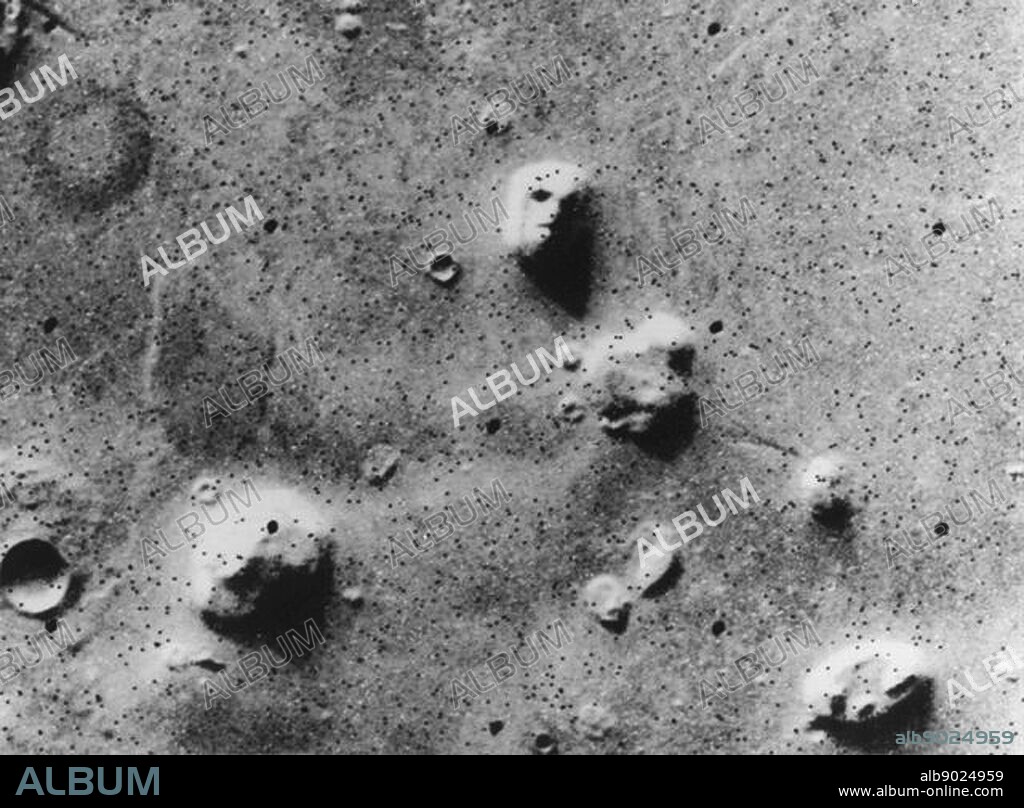alb9024959
Viking orbiter image of the 'Face on Mars,' taken 25 July 1976 On 22 July 2006, the DLR-operated High Resolution Stereo Camera (HRSC) on-board ESA's Mars Express obtained images of the Cydonia region, site of the famous 'Face on Mars.' The HRSC images include some of the most spectacular views of the Red Planet ever seen. The HRSC obtained image data in orbit 3253 with a ground resolution of approximately 13.7 metres per pixel. The data were acquired at a latitude of approximately 40.75 degrees North and about 350.54 East longitude. Triggered by a photo of the Cydonia region taken on 25 July 1976 by the American Viking 1 Orbiter, one of the visible remnant massifs has become famous during the last 30 years as the 'Face on Mars'. It was first publicly labelled as 'resembling a human head' in the NASA press release on 31 July 1976. Even then, NASA scientists interpreted the formation as an optical illusion caused by the illumination angle of the Sun and the surface morphology, with the resulting shadows giving the impression of eyes, nose and mouth. Nevertheless, in the following years, the 'Face on Mars' was the cause for much speculation about artificial structures on Mars, their possible origin and purpose. The 'Face on Mars' is the most famous formation in an array of structures which have been interpreted by some space-enthusiasts as artificial landscapes, such as potential pyramids and even a ruined city. The idea that Mars could have been home to intelligent beings inspired the imagination of many people interested in the Red Planet and was expressed in numerous, more or less serious, newspaper articles, in science-fiction literature, in television programmes, in computer games and on many webpages.

|
Add to another lightbox |
|
Add to another lightbox |



Buy this image.
Select the use:

Caption:
Viking orbiter image of the 'Face on Mars,' taken 25 July 1976 On 22 July 2006, the DLR-operated High Resolution Stereo Camera (HRSC) on-board ESA's Mars Express obtained images of the Cydonia region, site of the famous 'Face on Mars.' The HRSC images include some of the most spectacular views of the Red Planet ever seen. The HRSC obtained image data in orbit 3253 with a ground resolution of approximately 13.7 metres per pixel. The data were acquired at a latitude of approximately 40.75 degrees North and about 350.54 East longitude. Triggered by a photo of the Cydonia region taken on 25 July 1976 by the American Viking 1 Orbiter, one of the visible remnant massifs has become famous during the last 30 years as the 'Face on Mars'. It was first publicly labelled as 'resembling a human head' in the NASA press release on 31 July 1976. Even then, NASA scientists interpreted the formation as an optical illusion caused by the illumination angle of the Sun and the surface morphology, with the resulting shadows giving the impression of eyes, nose and mouth. Nevertheless, in the following years, the 'Face on Mars' was the cause for much speculation about artificial structures on Mars, their possible origin and purpose. The 'Face on Mars' is the most famous formation in an array of structures which have been interpreted by some space-enthusiasts as artificial landscapes, such as potential pyramids and even a ruined city. The idea that Mars could have been home to intelligent beings inspired the imagination of many people interested in the Red Planet and was expressed in numerous, more or less serious, newspaper articles, in science-fiction literature, in television programmes, in computer games and on many webpages.
Credit:
Album / World History Archive
Releases:
Model: No - Property: No
Rights questions?
Rights questions?
Image size:
8600 x 6343 px | 156.1 MB
Print size:
72.8 x 53.7 cm | 28.7 x 21.1 in (300 dpi)
Keywords:
 Pinterest
Pinterest Twitter
Twitter Facebook
Facebook Copy link
Copy link Email
Email
